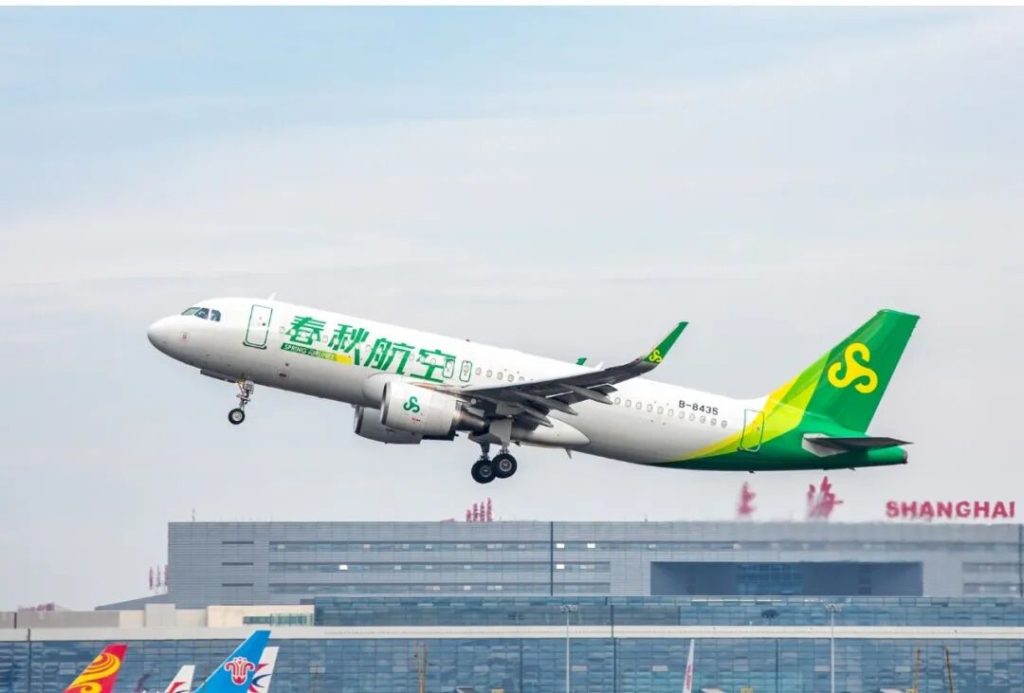
Read More《春秋航空赚钱的秘密:天上没有免费的午餐》
Positive Comment: The “Service Subtraction” Model Breaks the Deadlock Precisely, Providing a Differentiated Survival Sample for the Troubled Civil Aviation Industry
During the National Day Golden Week in 2025, the civil aviation industry once again fell into the embarrassing situation of “high passenger volume but low profitability” – the number of passengers reached a record high, but the three major state – owned airlines still failed to get out of the quagmire of losses. However, Spring Airlines, with the image of the “stingiest airline”, achieved a reverse profit. In the first half of the year, it had a net profit of 1.169 billion yuan and a net profit margin of over 10%. This not only stood out in the industry’s winter but also verified the strong vitality of the “ultra – low – cost” business model.
The success of Spring Airlines essentially lies in its precise capture of both “consumption trends” and “industry pain points”. The core feature of the current consumer market is “dominated by price – sensitive demand”: although the tourism demand is strong, consumers tend to “meet basic travel needs at a lower cost” and are reluctant to pay for premium services even if it means sleeping in tents or hitchhiking. Spring Airlines’ “service subtraction” strategy precisely fits this trend – canceling free meals, splitting additional services such as checked luggage, focusing on direct sales to reduce distribution costs, and frequently using red – eye flights to reduce take – off and landing fees. Each measure revolves around “reducing the basic ticket price”, converting cost advantages into price advantages by “not providing non – essential services”, and finally attracting a large number of users with “low prices”. Then, it achieves large – scale profitability through high seat occupancy rates and flight utilization rates.
The efficiency of this model is fully reflected in the financial data. Compared with the three major state – owned airlines, Spring Airlines has significantly lower unit seat – kilometer costs. Due to the provision of traditional services such as free meals and a high proportion of distribution (relying on OTA platforms), in 2024, the meal expenses of China Eastern Airlines and China Southern Airlines alone reached 4.227 billion yuan and 4.406 billion yuan respectively. Spring Airlines directly eliminated this rigid expenditure by canceling free meals, and its direct sales ratio on the official website exceeded 90%, significantly reducing distribution commissions (the distribution cost of traditional airlines usually accounts for 8% – 10% of revenue). In addition, the frequent use of red – eye flights (lower take – off and landing fees during non – peak hours) further compressed operating costs. The accumulation of these “stingy” details finally enabled Spring Airlines to maintain a net profit margin of over 10% even when the ticket price was lower than the industry average, and it even approached the operational efficiency of global aviation giant Delta Air Lines.
More importantly, Spring Airlines provides a differentiated way to break the deadlock for the civil aviation industry deeply trapped in the “involution” situation. The core contradiction in the current civil aviation industry is the double squeeze of “excess supply” and “price – sensitive demand” – 41 passenger airlines in the whole industry are in a decentralized competition, and combined with the direct competition of high – speed railways on more than 1900 routes, traditional airlines can only maintain their market share by “trading price for volume”, but fall into the vicious circle of “increasing revenue but not profit”. Spring Airlines avoids direct competition with full – service airlines through its asset – light model of “low cost + high turnover” and builds a moat in the niche market of “pursuing cost – effectiveness”. This “misaligned competition” strategy not only wins survival space for itself but also provides a new paradigm for the industry to “achieve profitability through refined operations rather than relying on high – end service premiums”.
Negative Comment: Excessive “Service Subtraction” Hides Reputation Risks, and the Sustainability of the Low – price Model Faces Multiple Challenges
Although Spring Airlines’ “low – cost” model has shown excellent financial performance, the hidden concerns behind it are also worthy of attention. From user experience to industry competition, from brand trust to policy environment, multiple challenges may restrict its long – term development.
First of all, if the boundary of “service subtraction” is not properly grasped, it may damage user experience and brand reputation. Spring Airlines splits traditional airlines’ “standard services” such as meals, checked luggage, and blankets into “paid items”, which reduces the basic ticket price. However, some passengers have to pay extra due to long flight times or temporary needs (such as traveling with children), and the final actual expenditure may exceed expectations. The Black Cat Complaint Platform shows that the number of complaints against Spring Airlines is as high as 14,612, mainly focusing on issues such as “hidden charges” and “service shrinkage”. For example, some passengers reported that “after buying a low – price ticket, the checked luggage fee is more expensive than the ticket itself” and “there is no free meal on a 3 – hour flight, and the price of food sold on the plane is relatively high”. This “low – price attraction + additional charges” model may achieve profitability through information asymmetry in the short term, but in the long run, if users form the perception that “low price = hidden high cost”, it will damage brand trust and reduce the repurchase rate.
Secondly, changes in the industry competition pattern may squeeze Spring Airlines’ survival space. Currently, the concentration of the domestic aviation industry is relatively low (the top four airlines only account for 47% of the market share). In order to compete for market share, full – service airlines have begun to imitate the strategy of “lowering prices to attract customers”. For example, under the pressure of losses, the three major state – owned airlines may reduce ticket prices by compressing some services (such as reducing the proportion of first – class cabins and lowering the meal standard) and compete directly with Spring Airlines. In addition, as the Civil Aviation Administration promotes the “anti – involution” policy (such as the “Self – Discipline Convention for Air Passenger Transport” restricting low – price dumping), the overall ticket price in the industry may tend to be stable. If Spring Airlines’ “low – price label” cannot form a significant difference from other airlines, its core competitiveness will be weakened.
Thirdly, there is a ceiling for the expansion of the “low – cost” model. Spring Airlines’ profitability highly depends on “high seat occupancy rates” and “high flight utilization rates”. However, the slot resources of popular domestic routes are limited, and the growth space of red – eye flights is also restricted by airport operating hours. If it needs to develop new routes or increase capacity in the future, it may face higher take – off and landing fees and marketing costs, resulting in an increase in unit costs. In addition, although consumers have a strong demand for “low prices”, their requirements for the “bottom line of basic services” are also increasing. For example, passengers can accept the absence of free meals, but they cannot accept frequent flight delays or poor in – flight hygiene conditions. If Spring Airlines over – compresses necessary services (such as reducing the number of crew members and lowering the aircraft maintenance frequency) to control costs, it may lead to safety hazards or a decline in service quality, which will ultimately harm the brand.
Suggestions for Entrepreneurs: Find a Dynamic Balance between “Cost Control” and “User Experience”
The case of Spring Airlines provides multi – dimensional inspiration for entrepreneurs, and the core lies in how to find a sustainable balance between “low cost” and “user value”. Based on its experience and challenges, the following suggestions are provided:
- Accurately position target users and clarify the boundary of “service subtraction”: The success of Spring Airlines stems from its accurate capture of “price – sensitive users”. Entrepreneurs need to first clarify the core needs of target users (such as “basic travel” rather than “high – end experience”), and then perform “service subtraction” around these needs – only retain the core functions that users care most about (such as on – time rate and basic safety) and cut off non – essential additional services (such as luxurious meals). At the same time, they need to clarify the “service bottom line” through user research to avoid the collapse of the user experience due to excessive cost compression.
- Resolve the controversy of “hidden charges” through “transparency”: Most of the complaints against Spring Airlines are due to “untransparent additional charges”. If entrepreneurs adopt the “basic low – price + optional payment” model, they need to clearly inform users of all possible costs (such as checked luggage fees and seat selection fees) before they make a decision to avoid trust crises caused by information asymmetry. For example, they can display the prices of all additional services in advance on the “fee details page” of the official website/APP, or launch “package pricing” (such as “economy class + 20kg checked luggage” and “economy class + simple meal”) to allow users to make independent choices.
- Achieve profitability through “efficiency improvement” rather than “simple cost compression”: Spring Airlines’ “low cost” does not rely on cutting corners but is achieved through efficiency optimization measures such as a “high direct sales ratio” and “utilization of red – eye flights”. Entrepreneurs should focus on improving “operational efficiency”. For example, they can reduce customer acquisition costs through digital tools (such as Spring Airlines’ high direct sales ratio) and optimize the supply chain to reduce waste (such as precisely controlling the inventory of in – flight meals) instead of simply reducing necessary services or lowering product quality.
- Build “differentiated barriers” to cope with competition: Facing the “price – cutting follow – up” of full – service airlines, Spring Airlines needs to strengthen its differentiated advantages. For example, it can form an ecological closed – loop of “travel + tourism” through “high – frequency short – haul routes” and “deep binding with tourism platforms” (such as the travel agency resources of the Spring Group), or establish advantages in user pain points such as “on – time rate” and “luggage transportation efficiency” to make “low price” and “reliable service” become the brand labels together.
- Pay attention to policies and industry trends and maintain model flexibility: The “anti – involution” policy in the civil aviation industry may change the industry price system. Entrepreneurs need to be sensitive to policies and adjust their strategies in a timely manner. For example, if the overall ticket price in the industry rises in the future, Spring Airlines can appropriately improve the basic service standard (such as providing free simple meals) to re – balance between “low price” and “experience”. If the policy restricts low – price competition, it needs to improve user stickiness through “value – added services” (such as membership rights and priority boarding) to avoid getting trapped in the “price war” quagmire.
Conclusion: Spring Airlines’ “service subtraction” model is a successful breakthrough under the background of rationalized consumption and industry involution. However, the replicability of its experience depends on the precise control of “user needs” and “cost efficiency”. For entrepreneurs, “low price” is never the goal but a means to create value for users through “cost optimization”. Only by finding a dynamic balance between “making users feel that it is cheap” and “enabling the enterprise to make continuous profits” can they go more steadily and further in the highly competitive market.
- Startup Commentary”Building LLMs: The Knowledge Graph Foundation Every AI Project Needs”
- Startup Commentary”The 17th Year of Tmall Double 11 and the New Map Rewritten by AI”
- Startup Commentary”How to Prepare Your Data for Artificial Intelligence”
- Startup Commentary”Small and Medium-sized Banks: “Cutting the Tail” in Loan Assistance”
- Startup Commentary”The Six AI Giants on Stage: AGI Is No Longer a “Future” Thing”




